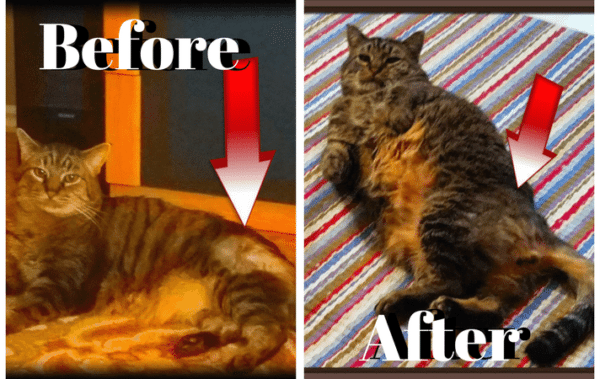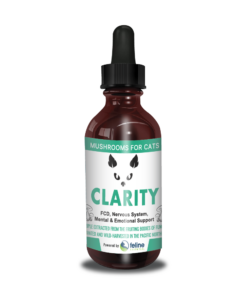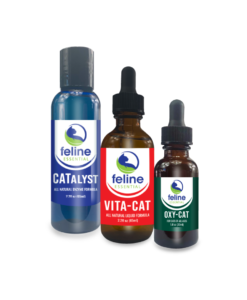Feline Hyperesthesia (FHS) is a weird “twitchy” disorder that makes your cat very uncomfortable. By definition, hyperesthesia means “abnormally increased sensitivity of the skin.” Since the cause of feline hyperesthesia is still unknown, ruling out other health issues first is necessary. Other common names used for this problem are ‘rippling skin syndrome,’ ‘rolling skin syndrome,’ or ‘twitchy cat syndrome’.
Sometimes cats with FHS will seem neurotic and chase their tails as if they’re not attached to their body. This strange behavior can happen out of nowhere. You may also see your cat dash from room to room and vocalize loudly while doing this.
Feline hyperesthesia is considered ‘idiopathic’ since the cause is unknown, however, studies show that it’s brought on by a combination of environmental and social irritants. Veterinarians in the medical field will prescribe a medication to help the symptoms of FHS. Unfortunately those chemicals don’t address the problem. In the holistic field we look to the root of the issue to correct the problem.
We’ve recently helped one of our customers cats with feline hyperesthesia, Bobo, grow his hair back and start playing like a normal kitty again in 3 simple steps (read his story below). If your kitty is biting, twitching or gnawing at himself/herself and you’ve ruled out allergies, dermatitis, infections and/or epilepsy – it’s time to start making a few easy changes that can make all the difference in the world to your kitties life.
3 Proven Ways To Help Feline Hyperesthesia
1. Anti-inflammatory enzyme supplements (a big word for something you can easily purchase online)
Environmental and nutritional stressors cause inflammation in the system. Whenever there is a skin problem there is an inflammation problem. Adding in an enzyme supplement like CATalyst liquid formula to the daily diet not only helps lower inflammation, but it also helps to lubricate the hair follicles and support the coat of your kitty. There’s no reason to not use a enzyme supplement like this because they can only help your cat’s health – and can never hurt.
2. Species appropriate diet (feed unprocessed foods)
Cats are made to eat their prey. This means a high protein, high moisture diet. If you can feed some or all raw in your cat’s diet this will reverse food allergies, help reduce nutritional stress as well as support the skin and coat. Take out the carbs and grains and help your cat with feline hyperesthesia get back to health.
3. Stress Reducers (routine, routine, routine)
Both of the above suggestions will help reduce your cat’s nutritional stressors but it is very important that you also focus on the social stressors. Natural anti-anxiety formulas are very beneficial for calming cats with FHS, but we should also focus on lifestyle. Many of us cat parents have busy lives and aren’t always scheduled in our day to day business but your cat needs you to put him/her on a routine. Cats are the least stressed when they don’t have to guess when they’re going to be fed or when their litter will be clean again. I set an alarm on my phone so that I don’t miss feeding times and the litter is changed every morning while I’m preparing breakfast for them. We have stress free cats now. Putting your cat with feline hyperesthesia on a strict routine will do wonders for his/her condition.
Following these 3 steps will give your cat a healthier life like Bobo, below.
Bobo – 10 yrs old | Feline Hyperesthesia, Food Allergies and Arthritis
Bobo’s mom, Darby, was at her wits end. She had tried everything to help poor Bobo stop biting himself and pulling his hair out. He had food allergies, severe arthritis & feline hyperesthesia. One spot on his back was nearly bald and always seemed to bother him.
Darby contacted Two Crazy Cat Ladies and discussed ways to help Bobo through diet and nutritional supplements. She purchased CATalyst liquid antioxidant formula (which Bobo loves), started transitioning his diet to raw and gave him a more structured daily routine.
In a couple of weeks the change were remarkable. Bobo’s hair started growing back and he was playful and happy again. His coat was shinier and he started jumping on the bed, which he had not done in a long time. Now Bobo doesn’t ‘twitch and itch’ and his skin issues are so much better!
Click here to read the story of Milly with Feline Hyperesthesia Syndrome
Buy the Feline Hyperesthesia Kit Now






Recent Comments